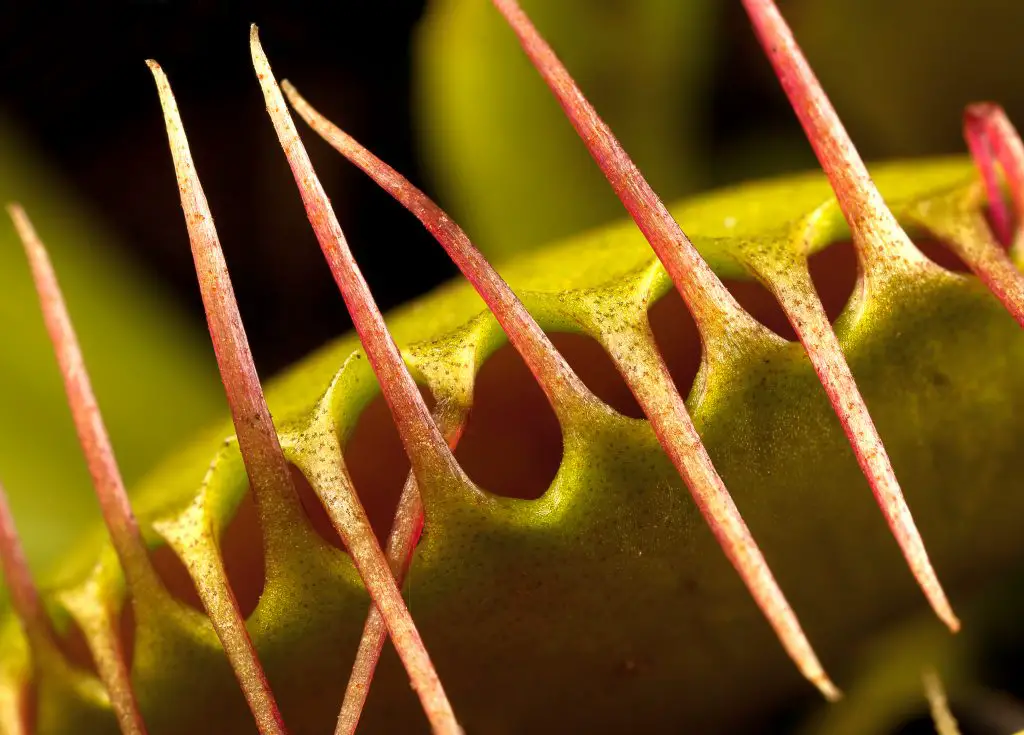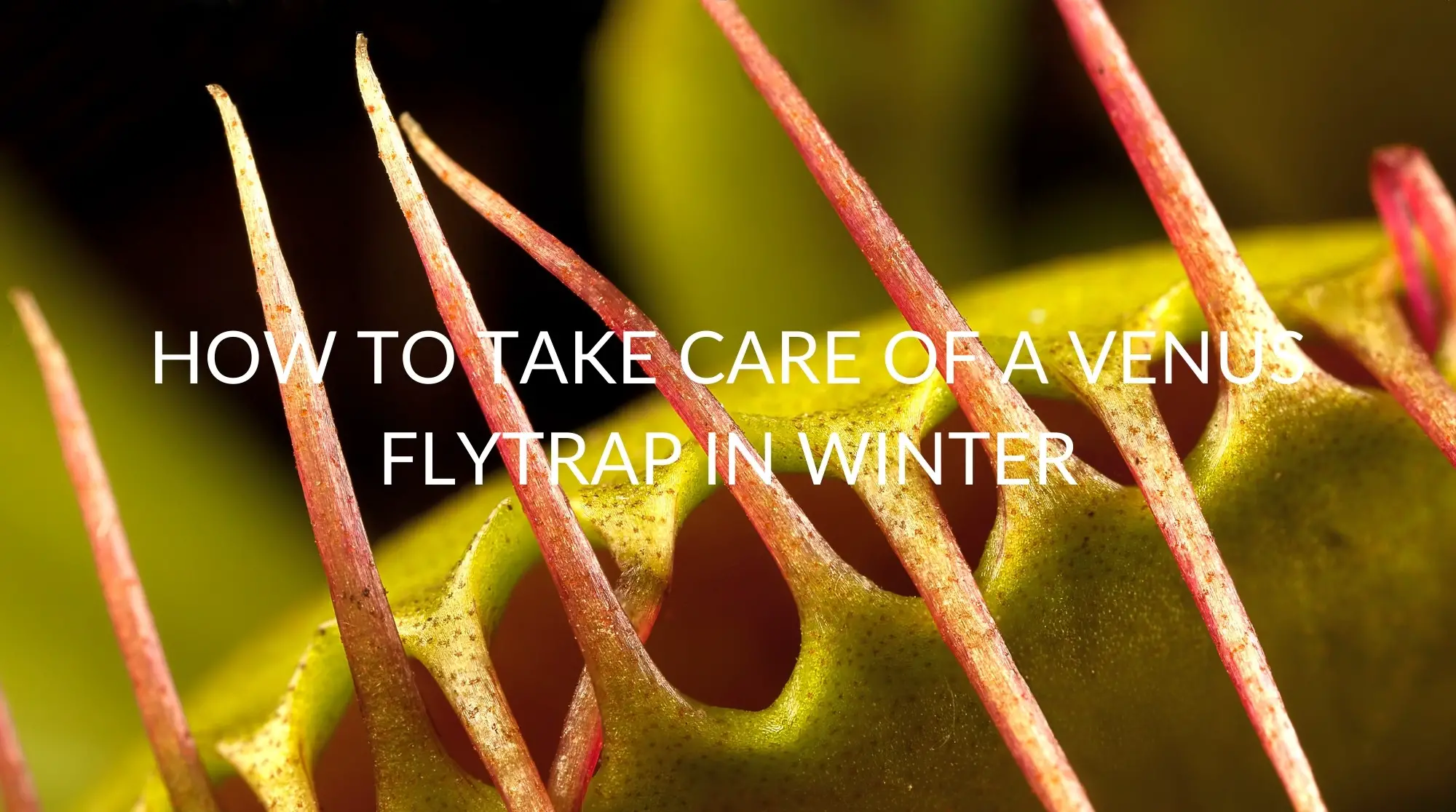The best way to take care of a Venus Fly Trap in winter is to prepare it for dormancy. This means, beginning in autumn, you will have to trim off dead growth, reduce watering, reduce exposure to light and find it a new home so it can acclimate to the dropping temperatures. However, you will have to protect the plant from frost.
Of course, this will largely rely on what growing zone you live in. But, the idea is to allow the plant a hibernation period so it will be big and strong during the spring and summer months when the plant is most vibrant. Keep reading to learn more about how to take care of a Venus Fly Trap in winter.
How Do I Keep My Venus Fly Trap Alive in The Winter?
The best way to keep your Venus Fly Trap alive in the winter is to start preparing it for dormancy toward the end of autumn, right before the first frost. Unlike other plants, dormancy is essential for Venus Fly Traps to remain healthy, hardy, and alive for years to come.
There’s another aspect to note about dormancy for Venus Fly Traps, and it’s important for caretakers to understand that not all will go dormant at the same rate. Generally speaking, the greener ones will maintain more traps than the red ones. Regardless, do not expect the traps to exhibit similar changes at the same time. Also, the changes will be different each year.
Skipping Dormancy
If you skip dormancy, the Venus Fly Trap will die within two to three years. They need this period of rest for their long-term health and to reset their biological processes while also conserving energy in the bulb. This is part of the plant’s evolution and adaptation. The shorter days and lack of food necessitate dormancy.
Another aspect of stalling dormancy is the fact that the Venus Fly Trap will produce straggly, weak leaves and flowers throughout their winter dormancy and when reawakening in spring. Dormancy will begin regardless of the plant catching flies. So, don’t mistake feeding as an indicator that the plant isn’t overwintering.
Signs of Dormancy
Therefore, when you notice the temperatures beginning to drop, or you see signs of dormancy fastening in the plant, you should put the plant in its winter location. Dormancy will occur in a Venus Fly Trap when the leaves begin to die back, and chlorophyll drains from the plant.
Remove Dead Leaves & Other Growth
With clean sheers or gardening scissors, remove any yellow and brown growth. Don’t allow it to go entirely black, as it can encourage Botrytis to attack the plant. This gray mold will begin eating the Venus Fly Trap from the root upwards. Once this takes hold, there will be no saving the plant.
Inspect the Plant for Pest Infestations
Once you’ve removed all the dead growth from your Venus Fly Trap, it’s essential to thoroughly inspect it for any potential pests. Look at the undersides of leaves and around the stem. Aphids, also known as greenflies, will be one of the more common. In the event you do find them, use a systemic insecticide to get rid of them.
If you don’t, they will spend the winter in these areas and drain the plant of its energy. When spring rolls around, they will overtake the plant to the point there will be no saving it.
Reduce Watering Schedule
Because the leaves and other dead growth encourage slower overall growth, the Venus Fly Trap will not need nearly as much water as winter comes in. Give just enough for the pot to draw in the water, and don’t water again until it’s mostly dry. This will usually be every seven to 10 days or so at first.
The best way to determine when the Venus Fly Trap will need more water is by how light the pot feels when you pick it up. If it’s light, you should water it. However, it’s imperative to understand that you shouldn’t neglect watering either. Do not let the Venus Fly Trap dry out entirely.
Overwintering Location
Also, the location your Venus Fly Trap sits in during the winter months will be crucial. They shouldn’t stay in the house. This is because the temperature they will require must be 55°F (12°C) but no warmer than 32°F (0°C). If it gets any warmer than this, it may cause the Venus Fly Trap to come out of dormancy far too soon.
So, zones 4 through 7 should keep them outdoors, but you should insulate and cover them. This will be especially poignant if temperatures get below freezing. It may be ideal to put them right into the soil of the backyard as they rest in the pot. This is because aboveground pots will not provide adequate protection from frosty temperatures.
Zones 3 or less should keep Venus Fly Traps indoors. Find a place in the garage, basement or patio for it. It should be somewhat sheltered and out of the way of direct breezes, but it should not be too warm either. It’s important to start this in autumn so the plant can acclimatize itself to the dropping temperatures.
How to Care for a Venus Fly Trap in Winter
Even when the Venus Fly Trap goes dormant, you will have to continue your care of it. This will be especially true if you choose to store it outside. You will have to stay on top of the weather, checking for shifts in temperature. Also, you should do any pruning or watering when it’s warmer and sunnier rather than windy and freezing.

Continue Removing Dead Growth
Pinch, pull or clip off the leaves, traps, and other dead growth throughout the winter. While this won’t be very often, you will have to do this periodically. Every few weeks or so, check the plant for dead, brown, and dying parts. Remove them as quickly as possible.
Position & Sunlight
While sunshine isn’t terribly important, you do want to ensure the Venus Fly Trap does receive some natural light. If your location/position of the plant doesn’t get any access to much light, you can place it in a room on a sunnier day for a couple of hours. Alternatively, you can place the plant in front of a grow light for a few hours each week.
Freezing Temperatures
Whether storing the plant indoors or outdoors, you will have to cover the plant when temperatures get well below freezing. You want to protect the Venus Fly Trap from frost, which can damage the plant. This will be especially true of the bulb. If it gets too cold, the frost can kill it.
Use burlap, cotton, or an old piece of fleece to cover the plant well. Be sure to secure the edges with bricks or rocks and cover the fabric with straw, leaves, or pine needles. This will help retain moisture and prevent freezing. If snow appears, this makes great insulation too. Your biggest concern is with temperature.
Deeper Dormancy
If you end up having a mild winter, you will have to ensure the plant experiences exposure to colder temperatures. This means you may have to use the refrigerator to achieve this. But, understand this should only be something you do as a last-ditch effort.
Using the fridge means the plant will not get natural light and air exposure. Therefore, it doesn’t simulate natural dormancy, and it can raise problems. So, if you really want to do this, understand there’s a risk involved, and it’s likely one or two won’t make it.
In lieu of this, it’s imperative to gradually reduce exposure to light and temperature before storing them there. This will increase their chances of survival. The idea is to reduce shock and stress to the Venus Fly Traps as much as possible.
- Refrigeration Method #1: To do this, cut off any additional growth above the soil, including green traps, and dampen the pot. Put this in a dark area of the fridge, preferably the vegetable drawer.
- Refrigeration Method #2: Alternatively, you can remove the plant from the pot entirely and wash the soil off. Then, trim the traps and spray/drench the plant in fungicide. This will prevent Botrytis from developing. Wrap the bulbs in moist paper toweling, place in a plastic bag with some breathing holes and put it in the vegetable drawer.
- For Both Methods: Check the plant every few weeks for fungal and mold growth and dose with more fungicide as needed. You can store it in the fridge for up to three months. Usually between December and February is best. However, some people report success with January through March. Of course this will depend on the growing zone you’re in and the kind of winter you experience.
Bringing It Out of Dormancy
When the Venus Fly Trap is ready to come back from hibernation, ensure the plant experiences light, heat, and air slowly. This should be gradual and progressive so as to prevent shock and stress. If you removed the Venus Fly Trap from its pot, you would have to repot in a clean container with a fresh peat moss mix.
The peat moss should be somewhat moist but not dry and not sopping wet. Avoid watering once transplanted for about one week. When you notice the plant growing and getting active, increase its watering and sunlight. Only provide fertilizer and flies when you know the growing season is in full swing.
Should I Water My Venus Fly Trap in Winter?
Yes, you should definitely water your Venus Fly Trap in winter. But, you don’t need to do it as often as you would during the growing season. However, ensure the soil is just moist enough to transfer nutrients to the bulbs. Ensure the soil isn’t sopping wet and never overwater.
Keep in mind that a little watering neglect is okay during the winter in regards to Venus Fly Traps. Not total neglect, but a wee bit is okay. Your concern should be around temperature and light more than water.
How Often Should You Water a Venus Fly Trap in Winter?
The frequency with which you should water a Venus Fly Trap in winter is about every 10 days to two weeks; or when the soil is dry. Having said that, the soil shouldn’t be bare-bones dry, but the pot should feel quite light when you lift it.
Lighting Requirements for Venus Fly Traps During Winter
Sunlight isn’t nearly as important for Venus Fly Traps during winter. While some is advisable, they will not need as much as what they do in spring and summer. But, it’s imperative to reduce shock to the plant as much as you can. This means reducing the plant’s exposure to light starting in autumn.
You want to ensure the plant doesn’t get any warmer than 55°F (12°C) too. You don’t want to risk the plant coming out of dormancy too soon. This is why natural light is better than grow light. There is a likelihood that a grow light will emit far too much warmth.
What Is the Best Way to Feed My Venus Fly Trap in the Winter?
Because your Venus Fly Trap will be dormant in winter, there’s no need to feed it. Never give any plant, including Venus Fly Traps, any fertilizer during their dormancy. This will destroy the bulb and kill the plant. They will start eating bugs on their own when they’re good and ready to do so.
Recap
Caring for a Venus Fly Trap in winter does require meticulous observation, but it’s not incredibly difficult. You just have to make sure the plant doesn’t incur an infestation during dormancy while keeping it away from too much heat and deep frosts. But, if you can make it through the first dormancy, you will soon understand how to enable their annual success.

